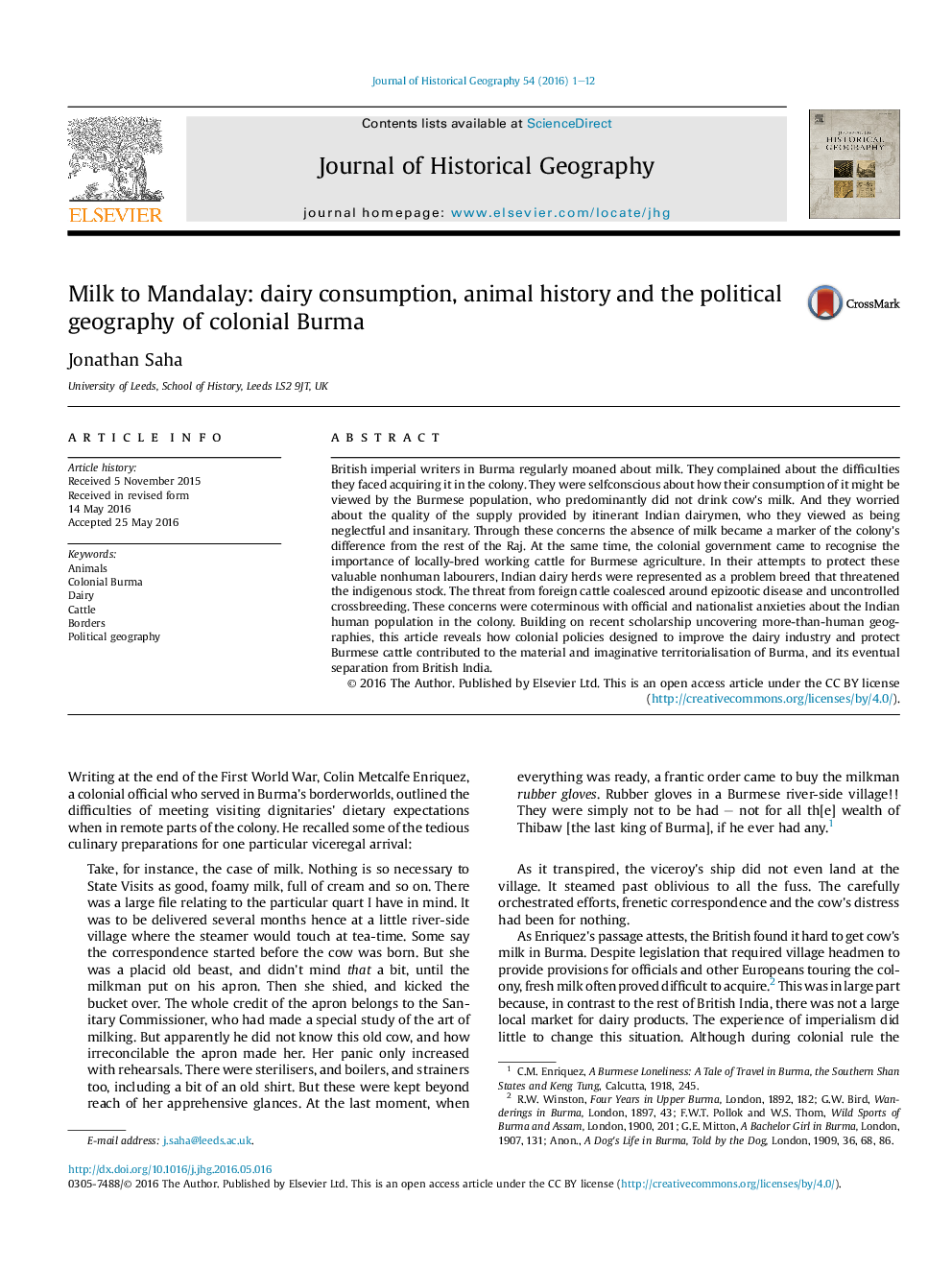| کد مقاله | کد نشریه | سال انتشار | مقاله انگلیسی | نسخه تمام متن |
|---|---|---|---|---|
| 7447174 | 1483971 | 2016 | 12 صفحه PDF | دانلود رایگان |
عنوان انگلیسی مقاله ISI
Milk to Mandalay: dairy consumption, animal history and the political geography of colonial Burma
ترجمه فارسی عنوان
شیر به ماندالای: مصرف لبنیات، تاریخ حیوانات و جغرافیای سیاسی بیروت استعماری
دانلود مقاله + سفارش ترجمه
دانلود مقاله ISI انگلیسی
رایگان برای ایرانیان
کلمات کلیدی
حیوانات، برمه استعماری، لبنیات، گاو، مرز ها، جغرافیا سیاسی
ترجمه چکیده
نویسندگان امپریالیست بریتانیا در برمه به طور منظم درباره شیر صحبت کردند. آنها در مورد مشکلاتی که آنها در معرض آن در مستعمره قرار داشت شکایت کردند. آنها خودخواه بودند در مورد چگونگی مصرف آنها از جمعیت برمه که غالبا شیر گاو را در نظر نگرفتند. و آنها نگران کیفیت عرضه ارائه شده توسط شراب تربیت شده در هند بودند، که آنها به عنوان غفلت و انزجار در نظر گرفته بودند. از طریق این نگرانی ها، عدم شیر تبدیل به نشانه ای از تفاوت کلنی از بقیه راج شد. در عین حال، دولت استعماری برای به رسمیت شناختن اهمیت گاوهای کاری محلی برای کشاورزی برمه بود. در تلاش های خود برای محافظت از این کارگران ارزشمند غیر انسانی، گله های شیری هند به عنوان یک نژاد مشکوک به شمار می رفتند که بومیان را تهدید می کرد. تهدید از گاوهای خارجی در اطراف بیماری های اپیزیونیک و کریستال های بدون کنترل کنترل می شود. این نگرانی ها با اضطراب رسمی و ناسیونالیستی در مورد جمعیت انسانی هندی در مستعمره سازگار بود. این مقاله بر اساس تحقیقات اخیر نشان می دهد که چگونه سیاست های استعماری برای بهبود صنایع لبنی و حفاظت از گاوهای برمه کمک می کند تا سرزمین سازی مادی و تخیلی برمه و جدایی آن از هند بریتانیا را کشف کنند.
موضوعات مرتبط
علوم انسانی و اجتماعی
علوم انسانی و هنر
تاریخ
چکیده انگلیسی
British imperial writers in Burma regularly moaned about milk. They complained about the difficulties they faced acquiring it in the colony. They were selfconscious about how their consumption of it might be viewed by the Burmese population, who predominantly did not drink cow's milk. And they worried about the quality of the supply provided by itinerant Indian dairymen, who they viewed as being neglectful and insanitary. Through these concerns the absence of milk became a marker of the colony's difference from the rest of the Raj. At the same time, the colonial government came to recognise the importance of locally-bred working cattle for Burmese agriculture. In their attempts to protect these valuable nonhuman labourers, Indian dairy herds were represented as a problem breed that threatened the indigenous stock. The threat from foreign cattle coalesced around epizootic disease and uncontrolled crossbreeding. These concerns were coterminous with official and nationalist anxieties about the Indian human population in the colony. Building on recent scholarship uncovering more-than-human geographies, this article reveals how colonial policies designed to improve the dairy industry and protect Burmese cattle contributed to the material and imaginative territorialisation of Burma, and its eventual separation from British India.
ناشر
Database: Elsevier - ScienceDirect (ساینس دایرکت)
Journal: Journal of Historical Geography - Volume 54, October 2016, Pages 1-12
Journal: Journal of Historical Geography - Volume 54, October 2016, Pages 1-12
نویسندگان
Jonathan Saha,
